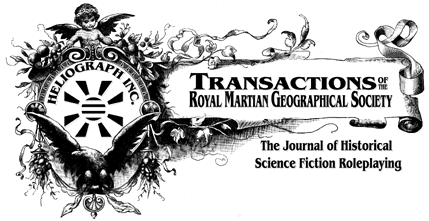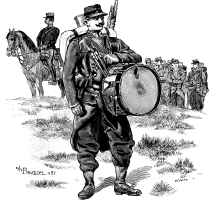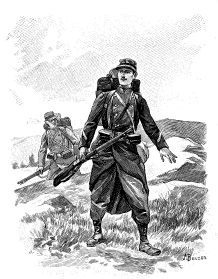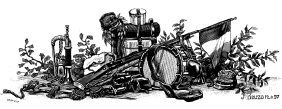
Buy | Submit | TRMGS1 | TRMGS2 | TRMGS3 | TRMGS4 |TRMGS Main | Heliograph Main
|
WHAT'S NEW?
The Complete Canal Priests Of Mars is now available!
The original publication of Canal Priests Of Mars cut slightly over a third of author Marcus L. Rowland's manuscript to fit GDW's adventure format.
The Complete Canal Priests Of Mars restores the cut material, features all new artwork by Paul Daly, and adds many useful player handouts. Enjoy the "author's cut" of a classic Space 1889 adventure, or experience it for the first time!
See our Buy It! page for more information!
Old news is still available on the News Page.
|
The French On Mars
by James L. Cambias
The French have always considered their nation to be the
fountainhead of civilization in Europe. During the colonial period, they
believed that France had a mission to spread that civilization across the Earth.
In the world of Space: 1889, the French would inevitably feel it
necessary to bring civilization to Mars, whether the Martians want it or not.
Idaeus Fons
The center of French influence on the Red Planet is the city-state
of Idaeus Fons, located in the highlands west of the Mare Acidalium.
Idaeus's population is about 80,000 Martians, with a resident
Terran population of 4000. Ninety percent of the Terrans in Idaeus are
French citizens (the remainder are mostly Americans and Italians). The city
is located on the Grand Canal which links the Mare Acidalium with
the Coprates Valley. The area around the city is arid and rough. Even
along the canals the farmland is marginal. The climate is generally cool,
similar to that of the Canadian Rockies.
Despite the terrain and climate, the city is prosperous. Its
economy is based on the canal trade and on metal production. The rugged
hills surrounding Idaeus hold some of the richest deposits of copper
and lead on Mars. For thousands of years the smithies of Idaeus have
produced copper pots and bowls, bronze tools, and cannon for export
to the Acidalium cities and the Coprates Valley.
Slavery was common in Idaeus until the arrival of the French.
Slaves worked the metal mines and rowed the canal boats. The French
abolished the slave trade and decreed that the children of slaves would
be free, but did not liberate those who were already enslaved.
Nowadays, the slave population in Idaeus is dwindling, and mostly consists of
household servants.
The language of Idaeus Fons is Thark, but a substantial
proportion of the population especially the upper classes speak
Na-Gaaryani. The most common Terran language is French.
The Surrounding Region
The rugged area surrounding Idaeus Fons is sparsely settled. A
few farms exist along the canals, but the chief occupation is herding.
The mines of Idaeus have been worked for millennia. The hills
and mountains of the region are honeycombed with ancient tunnels
and galleries. Many of these ancient mines have not been mapped in
recent memory. Brigands and fugitives often seek refuge in the mines,
and tales tell of horrible creatures dwelling underground.
The area around Idaeus is home to the Drukhma plant, an
extremely dangerous carnivorous plant armed with poisonous thorns. From
time to time Martians have been killed by this plant, but Terrans usually
suffer only a painful allergic reaction to the toxin.
French Control In Idaeus
The French presence in the Idaeus region dates back to 1873.
The first French scientific expedition to Mars, led by Dr. Claude
Massigny, landed near the city and established friendly relations with King
Lotmar, the ruler of Idaeus Fons.
More scientists followed, accompanied by merchants,
missionaries, and explorers. By 1875 nearly four hundred Frenchmen were living
in Idaeus. But anti-Terran sentiment was already growing in the
population, particularly among the nobility and the priests.
Riots broke out in July of 1877, when a mob of Martians attacked
a Bastille Day celebration. Six Frenchmen died in the fighting, and
much property was damaged. The French Consul demanded a full apology
and reparations from the King. When he refused, the French declared
war. Five regiments landed in November of 1877, and shattered the
city's army in three battles.
The French compelled King Lotmar to step down in favor of his
nephew Akvan. Several nobles were imprisoned, and their lands were
turned over to the French government as compensation. In 1878 King
Akvan signed a treaty accepting French military protection and guidance
in foreign affairs. Separate courts for French citizens were set up, and
a reduced tariff was set for goods brought in on French ether flyers.
Ambitious French officers seeking victories as the quickest route
to promotion conducted extensive campaigns on the frontier.
Independent towns were forced to recognize the sovereignty of Idaeus, and Hill
Martian tribes were subjugated or forced out. French columns pushed as
far as the rim of the Mare Acidalium in the east, the Tempe mountains
to the north, and several hundred miles across the deserts to in the
south and west.
The inhabitants of Idaeus Fons have an ambivalent attitude
toward the French. On one hand, the memories of the war of 1877 and
the humiliating treaty are bitter, and recent immigrants from the
Coprates tell horrifying tales. On the other hand, the city has prospered
economically due to trade with the French, the bureaucracy has been purged
of corruption, and patrols have nearly eliminated banditry in the
surrounding hills. The priests and what remains of the aristocracy are more
fervently anti-Terran than ever, but the merchants and the military
leaders have a growing respect for the aliens.
The French In Idaeus Today
Since 1877, the French presence in Idaeus Fons has grown
dramatically. French firms hold important business concessions a
French company now runs a steamship line to Nilokeras, and another owns
the largest lead mine in the area.
The scientific endeavors that initiated French involvement on
Mars are still going on. The Republic has established an
Institut Martien des Sciences in Idaeus Fons. The Institut occupies a large building,
formerly the palace of a noble family. Laboratories study Martian weather,
animals, plants, and minerals; as well as the culture and prehistory of
the Martians. The Institut sends expeditions ranging far over the surface
of Mars, and is generous in its sponsorship of independent explorers.
Where Frenchmen go, wine follows. Ten years ago a group of
vintners purchased a tract of land in the hills south of the city, and
began trying to raise grapes. After a few years spent experimenting with
various root stocks and fertilizers, the first bottles of
Maison Zoraad became commercially available. The wine has become quite popular
in Idaeus and elsewhere on Mars. Some other wineries have begun
operation in recent years, to keep up with the demand.
Government
Technically, the city of Idaeus Fons is still an independent
state, ruled by King Akvan. The only formal tie with
France is a treaty of alliance and a guarantee of protection for French citizens. In practice,
though, the city is run by General Pierre Saint-Honoré, the commander of
the French garrison. In addition to his French military rank,
Saint-Honoré also holds the title of "High Warlord" of Idaeus, making him second
in command after the King.
King Akvan is thoroughly under the General's thumb, and all
his edicts are drafted in Saint-Honoré's office. The various government
ministries of Idaeus Fons have all been stocked with French officials,
who answer to the General. The offices function honestly (though with
the usual French bureaucratic fussiness and sloth). The only part of
the government free from French influence is the law-courts. The
Martian judges have complete jurisdiction over all the Martian inhabitants
of Idaeus Fons, and the French do not interfere with them. A
separate French court decides cases involving Terrans.
Military Forces


The French currently have eight regiments
based in Idaeus Fons, plus the city's own army, which is
effectively under French command. The French units
are the 2nd Foreign Legion Infantry, the 3rd Marine
Infantry, the 79th, 81st and 114th Infantry
Regiments, the 1st Foreign Legion Cavalry, the 6th Hussars,
the Composite Regiment of Spahis, and five artillery
batteries (one horse artillery battery armed with
9-pounders, two mountain
batteries armed with 6-pounders, a field
battery with 15-pounders, and a heavy battery with 6"
howitzers).
The Idaeus Army is of Poor quality, and has
thirteen bands of infantry armed with muskets,
eight bands of cavalry, and twenty cannon. General
Saint-Honoré has organized one Good-quality infantry
regiment along European lines, with 180 men armed
with modern rifles and four field guns. All the officers
are French.
The Marines, the 79th Infantry, and the 81st
Infantry are based in the city, along with the
modern-style Martian regiment and six infantry bands. The remaining French units and the rest of the
Idaeus army are based in frontier posts. The French regiments are broken
up into separate battalions, and are paired with one or two Martian
bands. No Martian units are free of Terran supervision.
Despite their impressive force of ground troops, the French
have been handicapped by a lack of aerial vessels. Although the
mountains north of Idaeus Fons have plentiful liftwood groves, the city has no
shipyard. All of the city's cloudships were bought from
Acidalia or Niliacus. At one point, funds were allocated to have a pair of
Harpon-class aerial gunboats constructed at
Syrtis Major, but since the outbreak of the Oenotrian War, the British have been using the Syrtis yards at full
capacity for their own fleet.
Currently, the French operate the old Idaeus Fons cloudship
fleet, and have rearmed a few vessels with modern guns. The King still has
the Royal Yacht (an unarmed Clearsight screw galley). The fleet consists
of two Hullcutter screw galleys, a Whisperdeath
kite, a Sky Runner galley armed with a 3" gun and two 6-pounder Hotchkiss cannons,
a Bloodrunner kite armed with 6-pounder HRCs, and two
Swiftwood kites, one of which has been rearmed with a 4" short gun and two
3-pounder HRCs. The fleet is Trained quality. All marines are drawn from the
French 3rd Marine Infantry; they are Experienced troops armed with
modern rifles.
French Influence Outside Idaeus
While Idaeus Fons is the only city under French political
contril, most of the surrounding cities have small groups of French
merchants. Many have signed treaties of friendship with
France, and the rulers take great pains to avoid outbreaks of anti-Terran violence that might
provoke a military response.
Acidalia: The French presence in Acidalia is growing. There are
numerous French merchants, and plans are afoot to have officers in
the army trained by the French. Both the government and the inhabitants
of Acidalia are friendly towards France.
Chryse: Prince Tarkrakar of Chryse has tried to steer a course
that will enrich himself and his city. He has welcomed French assistance
in building a highly efficient army, and dreams of conquering
Niliacus with French help. He is trying to balance the French against the
Tossians and so retain his autonomy. Tarkrakar has worked on developing his
military, and in doing so has neglected the administration and economy
of his city.
Nilokeras: Osuuva, the Potentate of
Nilokeras, is decadent and incompetent. Under his rule the city's economy, government, and
military have all declined to an abysmal level. French influence here is
strong, and the terrible state of the city's military has made it a virtual
French protectorate. The government is very unstable only French
subsidies and support keep it afloat.
Niliacus: Prince Dardag of Niliacus is a weak ruler dominated by
the priests of the city. High Priest Aaverdigon recently became Prime
Minister. Niliacus has the nearest and largest shipyard available to
Idaeus Fons, and the French have worked very hard to woo the prince.
The priests are very intolerant of dissent and heresy, and require all
human visitors to remain in the Foreign Quarter of the city at all times.
There is a small French presence in Niliacus, which the
government tolerates only due to fear of possible intervention. A small faction
of military and mercantile interests wish to see the city modernized,
but they are still very much a minority.
Relations With Other Colonial Powers
The Belgians: The French attitude toward the
Belgians on Mars is compounded equally of patronization, envy, and exasperation. The
French have always viewed Belgium as a kind of detached province of
France, and so tend to view Belgian colonial activities as an extension of
their own. Certainly Frenchmen make up the largest contingent of
foreigners in the Coprates.
At the same time, French commanders and officials on Mars
are terribly jealous of the support given to Belgian colonial activities by
the government on Earth. They compare it with the unhelpful attitude
of their own government. French forces on Mars dwarf the
Belgian army in the Coprates, and with enough backing they could have annexed
the entire Mare Acidalium by now.
Finally, the French are profoundly irritated by the clumsy and
barbaric methods used by the Belgian Coprates Company. (It isn't the
barbarity itself that annoys them so much as unnecessary barbarism).
The Belgians make all the other Terrans look bad. The thought has
occasionally been expressed that the Coprates might be run better by some
other power... France, perhaps.
The Americans: Growing American influence centered
at Thymiamata has led to conflicts between French and American
commercial interests in Chryse and Niliacus. This is not very serious,
however, since the eyes of the French are mostly turned towards the
Mare Acidalium region, while the Americans are more interested in the
Tossian Empire. Relations between the two nations are good, and this is
reflected by cooperation among French and American officials on Mars,
especially concerning the extradition of criminals, suppression of piracy,
and efforts to control anti-Terran agitation.
The Germans: Since 1871 French relations with
Germany have been uniformly bad. On Mars, what little contact the two nations have
has been chilly, but officially polite. Both sides have set up spy networks
in the other's sphere of influence, and both work to undermine the
other's colonial efforts. Several times the French have sent anonymous tips
to the British about German operations in the Boreosyrtis cities. The
Germans have been quietly expanding their presence in the Mare
Acidalium, and have made friendly overtures towards cities that might have
cause to fear the French.
The British: French relations with Britain are currently at their
lowest ebb since Waterloo. This is curious, since both countries are
concerned about growing German power. But colonial rivalries in Africa
and Southeast Asia have caused a deep rift between the two
governments, and centuries of habit are hard to break.
On Mars, French and British interests do not directly compete,
since their respective spheres of influence are far apart. But there is still
no love lost between them. French arms merchants have been active
in Shastapsh, and there has been talk of French-made rifles being found
in Oenotrian hands.
The French government depends heavily on the British
heliograph system for rapid communication, and cannot build any gunboats on
Mars without British cooperation all of which is intolerable to French pride.
Conflict between the two is mostly at the level of continual
minor annoyances on both sides. The fact is that there is really a great deal
of common interest in their colonial activities, but a potentially fruitful
cooperation has been poisoned by bad feeling.

Posted Monday, 04-May-2009 19:50:24 EDT
Return to Main Page
Comments to webmaster@heliograph.com
The material on this page is Copyright 2000 under the author or artist's name unless noted otherwise, and cannot be used without permission. This presentation Copyright 2000 by Heliograph, Inc. Space:1889 is a registered trademark of Frank Chadwick, all rights reserved, and is used with his permission. Most other game, movie, or book names may be trademarks of their respective holders, and use of a trademark at this site should not be construed as implying the sponsorship of the trademark holder, nor, conversely, should use of the name of any product without mention of trademark status be construed as a challenge to such status. Heck no! We love those guys.
